University Sustainable Tourism Development: A Comprehensive Report
VerifiedAdded on 2020/01/28
|25
|6817
|64
Report
AI Summary
This report provides a comprehensive analysis of sustainable tourism development, focusing on the Philippines as a case study. It explores the benefits of tourism planning for stakeholders, examining public/private sector partnerships, and evaluating tourism development at different levels, including national, international, regional, and local planning. The report analyzes interactive planning systems and processes, emphasizing their significance in tourism development. It also assesses various methods for measuring tourist impact, such as pro-poor and responsible tourism. Furthermore, the report justifies the introduction of sustainability in tourism, analyzes factors hindering sustainable development, and examines different stages in planning for sustainability. It evaluates methods for resolving conflicts of interest, analyzes the implications of balancing supply and demand, and assesses the ethical issues of enclave tourism. Finally, the report compares current issues in developing and emerging destinations and discusses the future of tourism in the Philippines, providing a detailed overview of the topic.
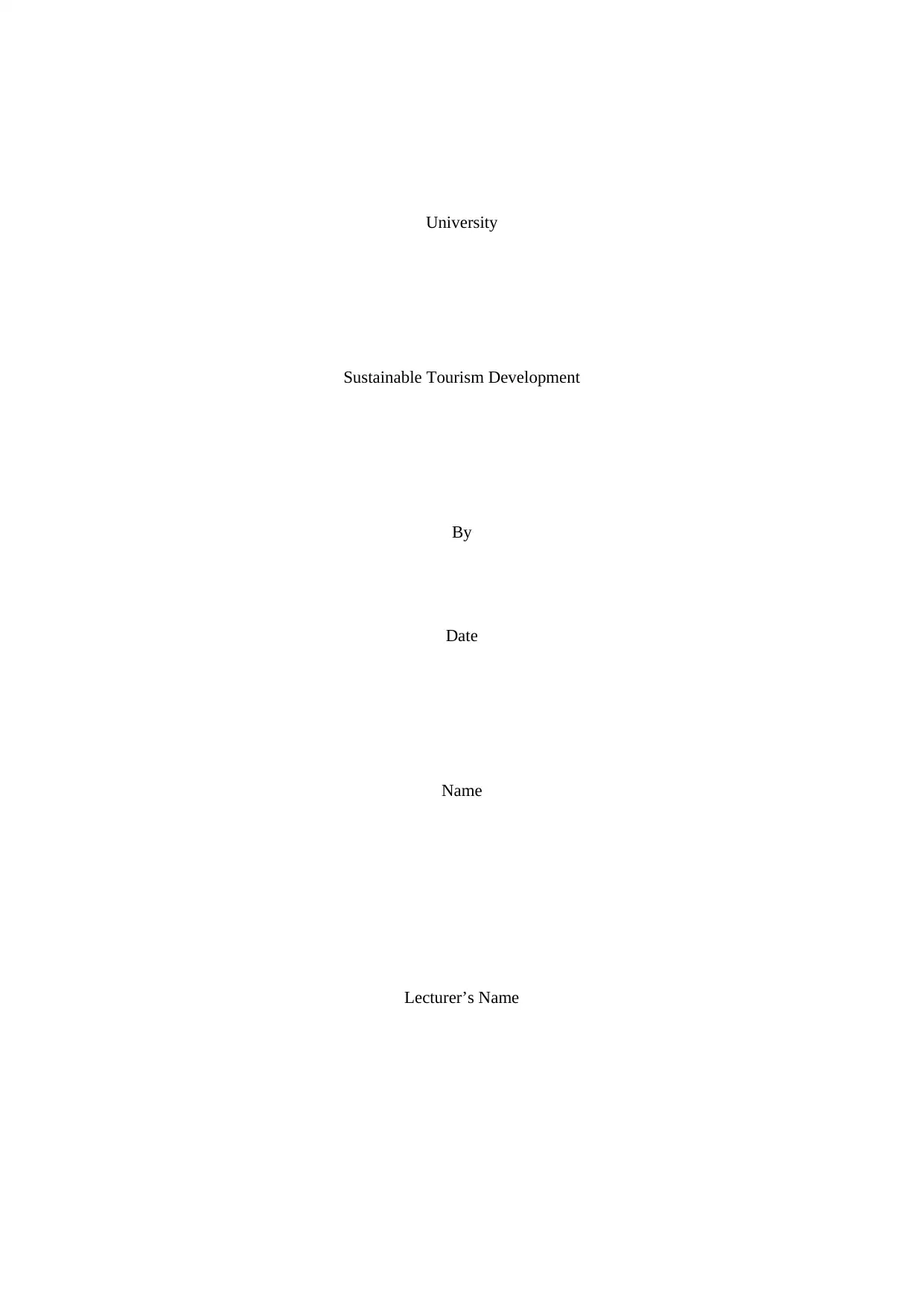
University
Sustainable Tourism Development
By
Date
Name
Lecturer’s Name
Sustainable Tourism Development
By
Date
Name
Lecturer’s Name
Paraphrase This Document
Need a fresh take? Get an instant paraphrase of this document with our AI Paraphraser
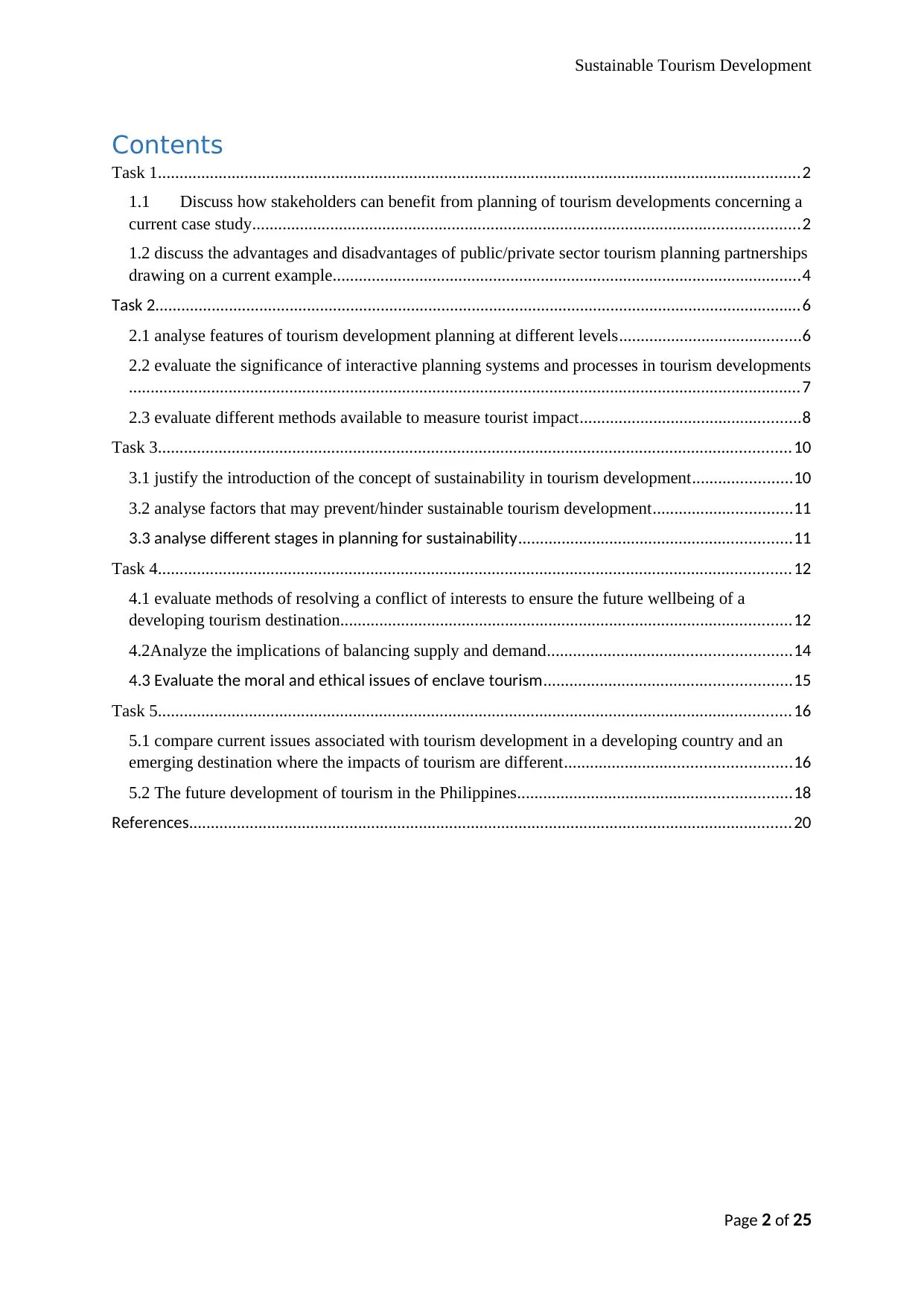
Sustainable Tourism Development
Contents
Task 1....................................................................................................................................................2
1.1 Discuss how stakeholders can benefit from planning of tourism developments concerning a
current case study..............................................................................................................................2
1.2 discuss the advantages and disadvantages of public/private sector tourism planning partnerships
drawing on a current example............................................................................................................4
Task 2.....................................................................................................................................................6
2.1 analyse features of tourism development planning at different levels..........................................6
2.2 evaluate the significance of interactive planning systems and processes in tourism developments
...........................................................................................................................................................7
2.3 evaluate different methods available to measure tourist impact...................................................8
Task 3..................................................................................................................................................10
3.1 justify the introduction of the concept of sustainability in tourism development.......................10
3.2 analyse factors that may prevent/hinder sustainable tourism development................................11
3.3 analyse different stages in planning for sustainability...............................................................11
Task 4..................................................................................................................................................12
4.1 evaluate methods of resolving a conflict of interests to ensure the future wellbeing of a
developing tourism destination........................................................................................................12
4.2Analyze the implications of balancing supply and demand........................................................14
4.3 Evaluate the moral and ethical issues of enclave tourism.........................................................15
Task 5..................................................................................................................................................16
5.1 compare current issues associated with tourism development in a developing country and an
emerging destination where the impacts of tourism are different....................................................16
5.2 The future development of tourism in the Philippines...............................................................18
References...........................................................................................................................................20
Page 2 of 25
Contents
Task 1....................................................................................................................................................2
1.1 Discuss how stakeholders can benefit from planning of tourism developments concerning a
current case study..............................................................................................................................2
1.2 discuss the advantages and disadvantages of public/private sector tourism planning partnerships
drawing on a current example............................................................................................................4
Task 2.....................................................................................................................................................6
2.1 analyse features of tourism development planning at different levels..........................................6
2.2 evaluate the significance of interactive planning systems and processes in tourism developments
...........................................................................................................................................................7
2.3 evaluate different methods available to measure tourist impact...................................................8
Task 3..................................................................................................................................................10
3.1 justify the introduction of the concept of sustainability in tourism development.......................10
3.2 analyse factors that may prevent/hinder sustainable tourism development................................11
3.3 analyse different stages in planning for sustainability...............................................................11
Task 4..................................................................................................................................................12
4.1 evaluate methods of resolving a conflict of interests to ensure the future wellbeing of a
developing tourism destination........................................................................................................12
4.2Analyze the implications of balancing supply and demand........................................................14
4.3 Evaluate the moral and ethical issues of enclave tourism.........................................................15
Task 5..................................................................................................................................................16
5.1 compare current issues associated with tourism development in a developing country and an
emerging destination where the impacts of tourism are different....................................................16
5.2 The future development of tourism in the Philippines...............................................................18
References...........................................................................................................................................20
Page 2 of 25
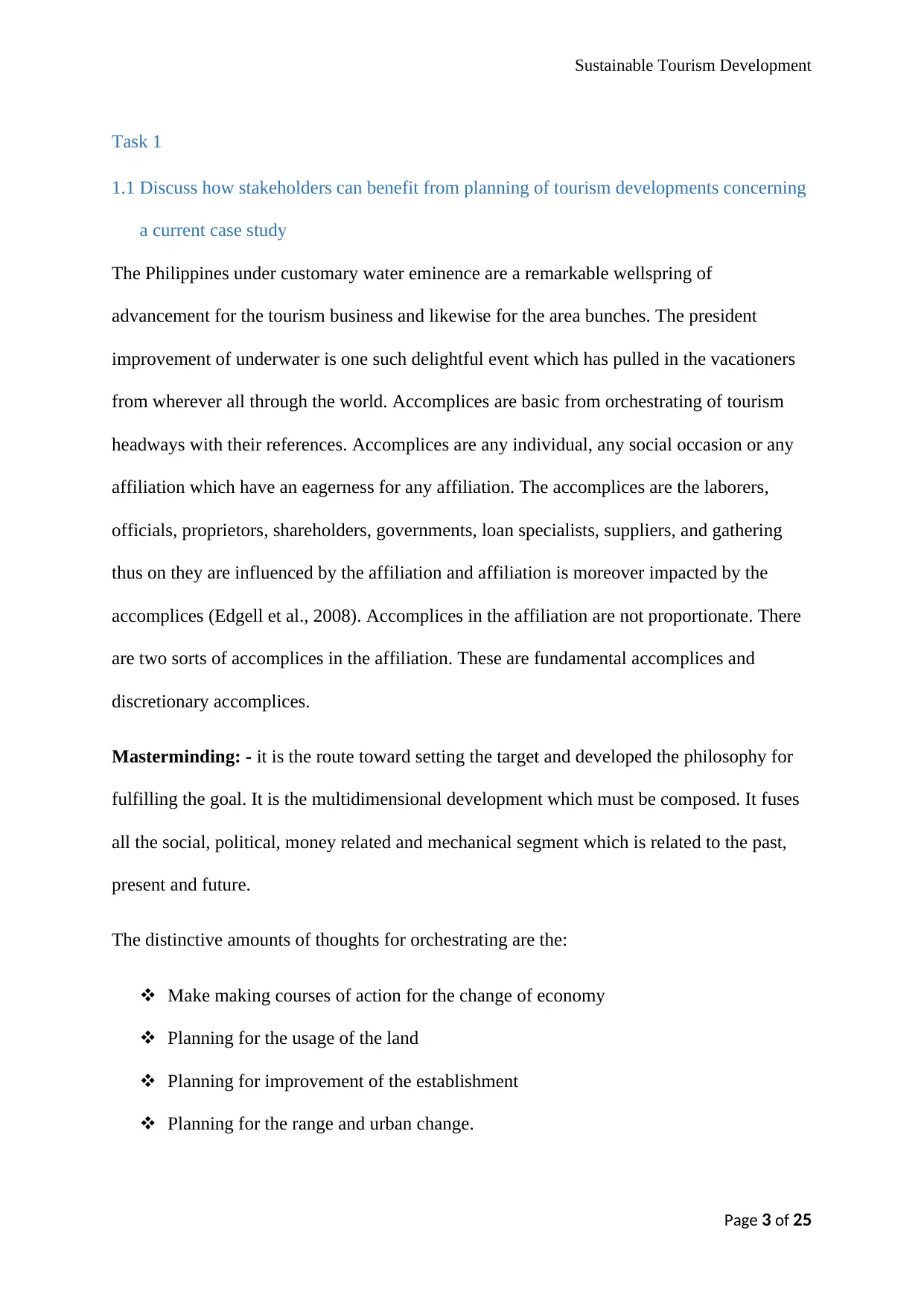
Sustainable Tourism Development
Task 1
1.1 Discuss how stakeholders can benefit from planning of tourism developments concerning
a current case study
The Philippines under customary water eminence are a remarkable wellspring of
advancement for the tourism business and likewise for the area bunches. The president
improvement of underwater is one such delightful event which has pulled in the vacationers
from wherever all through the world. Accomplices are basic from orchestrating of tourism
headways with their references. Accomplices are any individual, any social occasion or any
affiliation which have an eagerness for any affiliation. The accomplices are the laborers,
officials, proprietors, shareholders, governments, loan specialists, suppliers, and gathering
thus on they are influenced by the affiliation and affiliation is moreover impacted by the
accomplices (Edgell et al., 2008). Accomplices in the affiliation are not proportionate. There
are two sorts of accomplices in the affiliation. These are fundamental accomplices and
discretionary accomplices.
Masterminding: - it is the route toward setting the target and developed the philosophy for
fulfilling the goal. It is the multidimensional development which must be composed. It fuses
all the social, political, money related and mechanical segment which is related to the past,
present and future.
The distinctive amounts of thoughts for orchestrating are the:
Make making courses of action for the change of economy
Planning for the usage of the land
Planning for improvement of the establishment
Planning for the range and urban change.
Page 3 of 25
Task 1
1.1 Discuss how stakeholders can benefit from planning of tourism developments concerning
a current case study
The Philippines under customary water eminence are a remarkable wellspring of
advancement for the tourism business and likewise for the area bunches. The president
improvement of underwater is one such delightful event which has pulled in the vacationers
from wherever all through the world. Accomplices are basic from orchestrating of tourism
headways with their references. Accomplices are any individual, any social occasion or any
affiliation which have an eagerness for any affiliation. The accomplices are the laborers,
officials, proprietors, shareholders, governments, loan specialists, suppliers, and gathering
thus on they are influenced by the affiliation and affiliation is moreover impacted by the
accomplices (Edgell et al., 2008). Accomplices in the affiliation are not proportionate. There
are two sorts of accomplices in the affiliation. These are fundamental accomplices and
discretionary accomplices.
Masterminding: - it is the route toward setting the target and developed the philosophy for
fulfilling the goal. It is the multidimensional development which must be composed. It fuses
all the social, political, money related and mechanical segment which is related to the past,
present and future.
The distinctive amounts of thoughts for orchestrating are the:
Make making courses of action for the change of economy
Planning for the usage of the land
Planning for improvement of the establishment
Planning for the range and urban change.
Page 3 of 25
⊘ This is a preview!⊘
Do you want full access?
Subscribe today to unlock all pages.

Trusted by 1+ million students worldwide
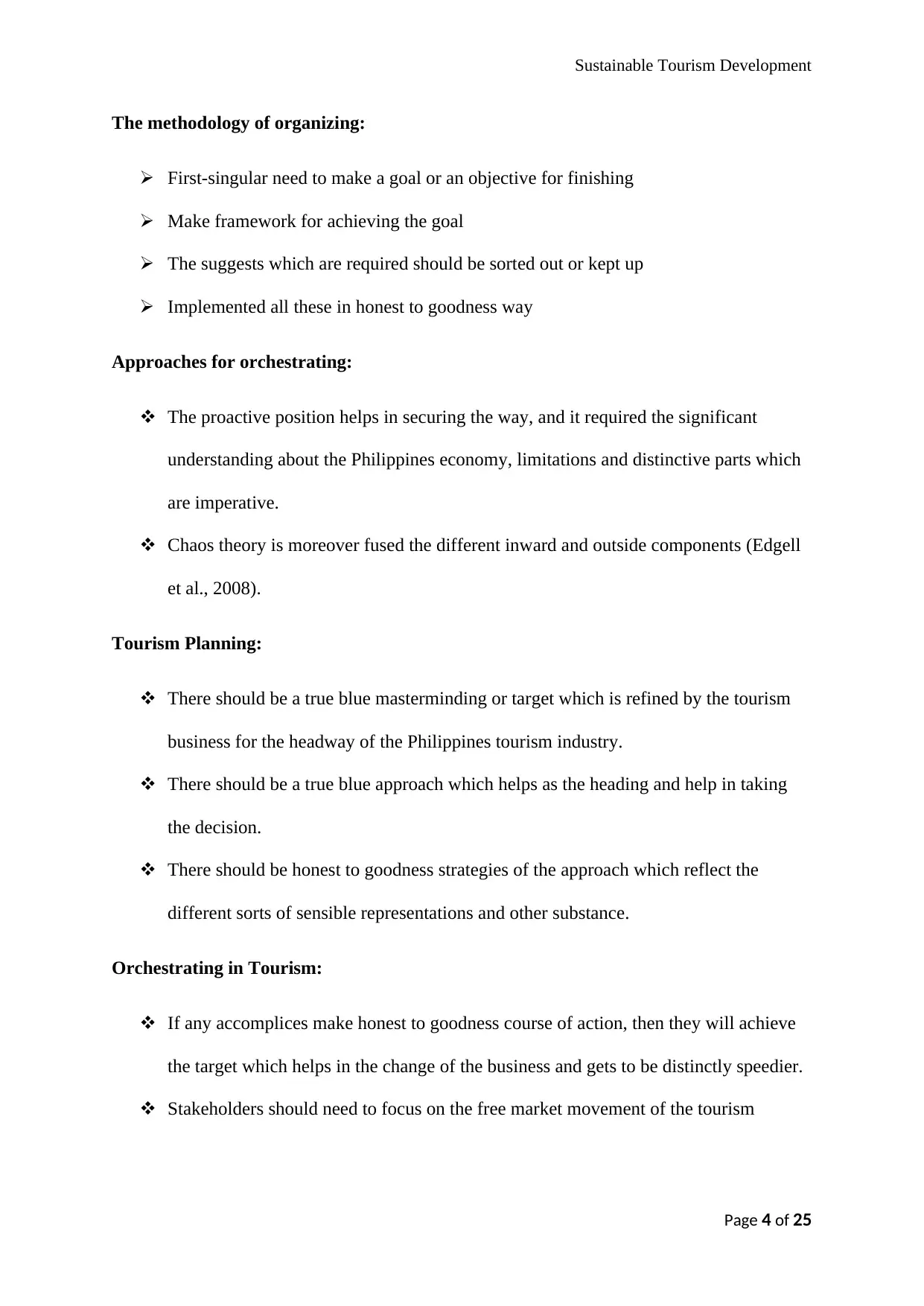
Sustainable Tourism Development
The methodology of organizing:
First-singular need to make a goal or an objective for finishing
Make framework for achieving the goal
The suggests which are required should be sorted out or kept up
Implemented all these in honest to goodness way
Approaches for orchestrating:
The proactive position helps in securing the way, and it required the significant
understanding about the Philippines economy, limitations and distinctive parts which
are imperative.
Chaos theory is moreover fused the different inward and outside components (Edgell
et al., 2008).
Tourism Planning:
There should be a true blue masterminding or target which is refined by the tourism
business for the headway of the Philippines tourism industry.
There should be a true blue approach which helps as the heading and help in taking
the decision.
There should be honest to goodness strategies of the approach which reflect the
different sorts of sensible representations and other substance.
Orchestrating in Tourism:
If any accomplices make honest to goodness course of action, then they will achieve
the target which helps in the change of the business and gets to be distinctly speedier.
Stakeholders should need to focus on the free market movement of the tourism
Page 4 of 25
The methodology of organizing:
First-singular need to make a goal or an objective for finishing
Make framework for achieving the goal
The suggests which are required should be sorted out or kept up
Implemented all these in honest to goodness way
Approaches for orchestrating:
The proactive position helps in securing the way, and it required the significant
understanding about the Philippines economy, limitations and distinctive parts which
are imperative.
Chaos theory is moreover fused the different inward and outside components (Edgell
et al., 2008).
Tourism Planning:
There should be a true blue masterminding or target which is refined by the tourism
business for the headway of the Philippines tourism industry.
There should be a true blue approach which helps as the heading and help in taking
the decision.
There should be honest to goodness strategies of the approach which reflect the
different sorts of sensible representations and other substance.
Orchestrating in Tourism:
If any accomplices make honest to goodness course of action, then they will achieve
the target which helps in the change of the business and gets to be distinctly speedier.
Stakeholders should need to focus on the free market movement of the tourism
Page 4 of 25
Paraphrase This Document
Need a fresh take? Get an instant paraphrase of this document with our AI Paraphraser
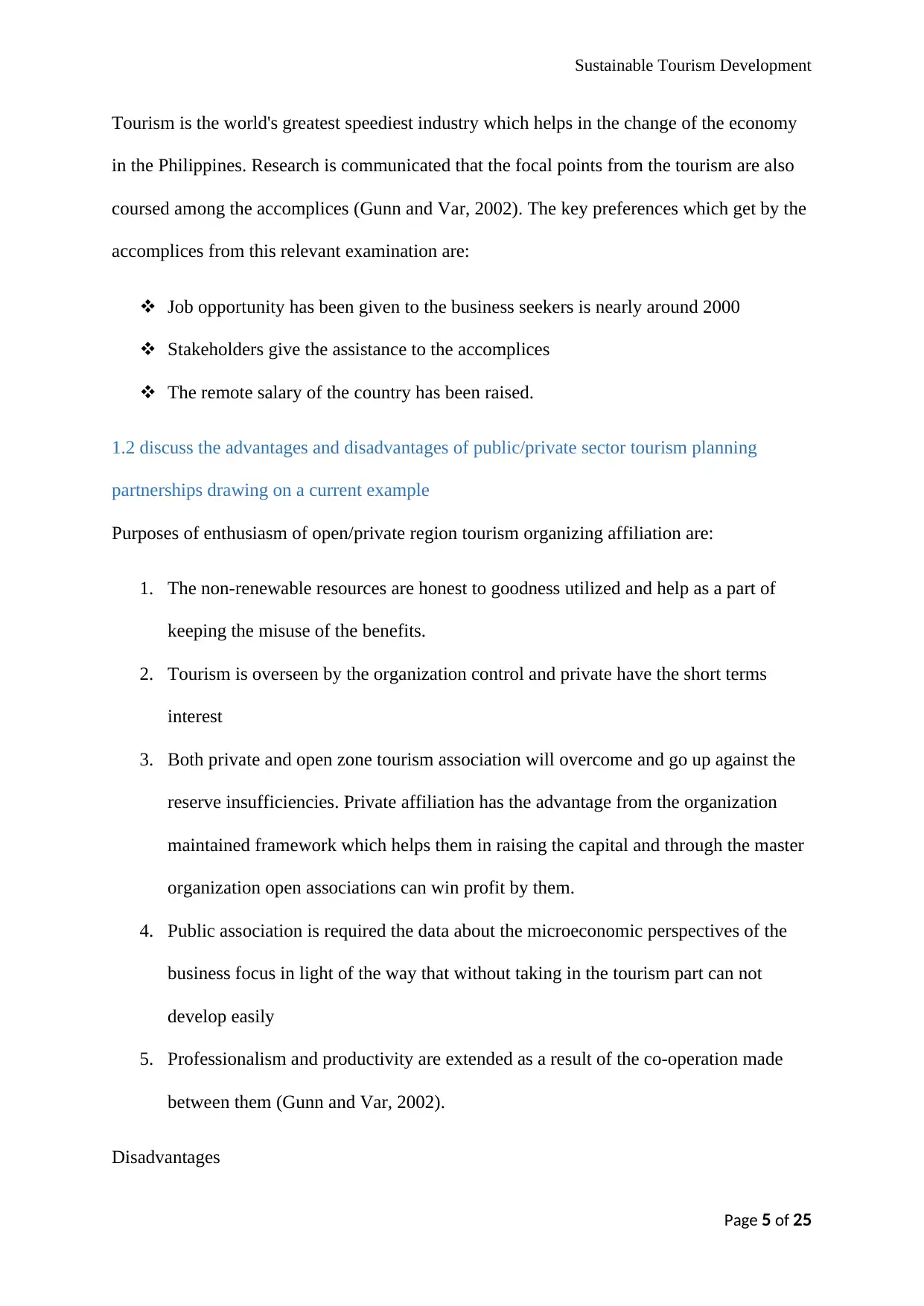
Sustainable Tourism Development
Tourism is the world's greatest speediest industry which helps in the change of the economy
in the Philippines. Research is communicated that the focal points from the tourism are also
coursed among the accomplices (Gunn and Var, 2002). The key preferences which get by the
accomplices from this relevant examination are:
Job opportunity has been given to the business seekers is nearly around 2000
Stakeholders give the assistance to the accomplices
The remote salary of the country has been raised.
1.2 discuss the advantages and disadvantages of public/private sector tourism planning
partnerships drawing on a current example
Purposes of enthusiasm of open/private region tourism organizing affiliation are:
1. The non-renewable resources are honest to goodness utilized and help as a part of
keeping the misuse of the benefits.
2. Tourism is overseen by the organization control and private have the short terms
interest
3. Both private and open zone tourism association will overcome and go up against the
reserve insufficiencies. Private affiliation has the advantage from the organization
maintained framework which helps them in raising the capital and through the master
organization open associations can win profit by them.
4. Public association is required the data about the microeconomic perspectives of the
business focus in light of the way that without taking in the tourism part can not
develop easily
5. Professionalism and productivity are extended as a result of the co-operation made
between them (Gunn and Var, 2002).
Disadvantages
Page 5 of 25
Tourism is the world's greatest speediest industry which helps in the change of the economy
in the Philippines. Research is communicated that the focal points from the tourism are also
coursed among the accomplices (Gunn and Var, 2002). The key preferences which get by the
accomplices from this relevant examination are:
Job opportunity has been given to the business seekers is nearly around 2000
Stakeholders give the assistance to the accomplices
The remote salary of the country has been raised.
1.2 discuss the advantages and disadvantages of public/private sector tourism planning
partnerships drawing on a current example
Purposes of enthusiasm of open/private region tourism organizing affiliation are:
1. The non-renewable resources are honest to goodness utilized and help as a part of
keeping the misuse of the benefits.
2. Tourism is overseen by the organization control and private have the short terms
interest
3. Both private and open zone tourism association will overcome and go up against the
reserve insufficiencies. Private affiliation has the advantage from the organization
maintained framework which helps them in raising the capital and through the master
organization open associations can win profit by them.
4. Public association is required the data about the microeconomic perspectives of the
business focus in light of the way that without taking in the tourism part can not
develop easily
5. Professionalism and productivity are extended as a result of the co-operation made
between them (Gunn and Var, 2002).
Disadvantages
Page 5 of 25
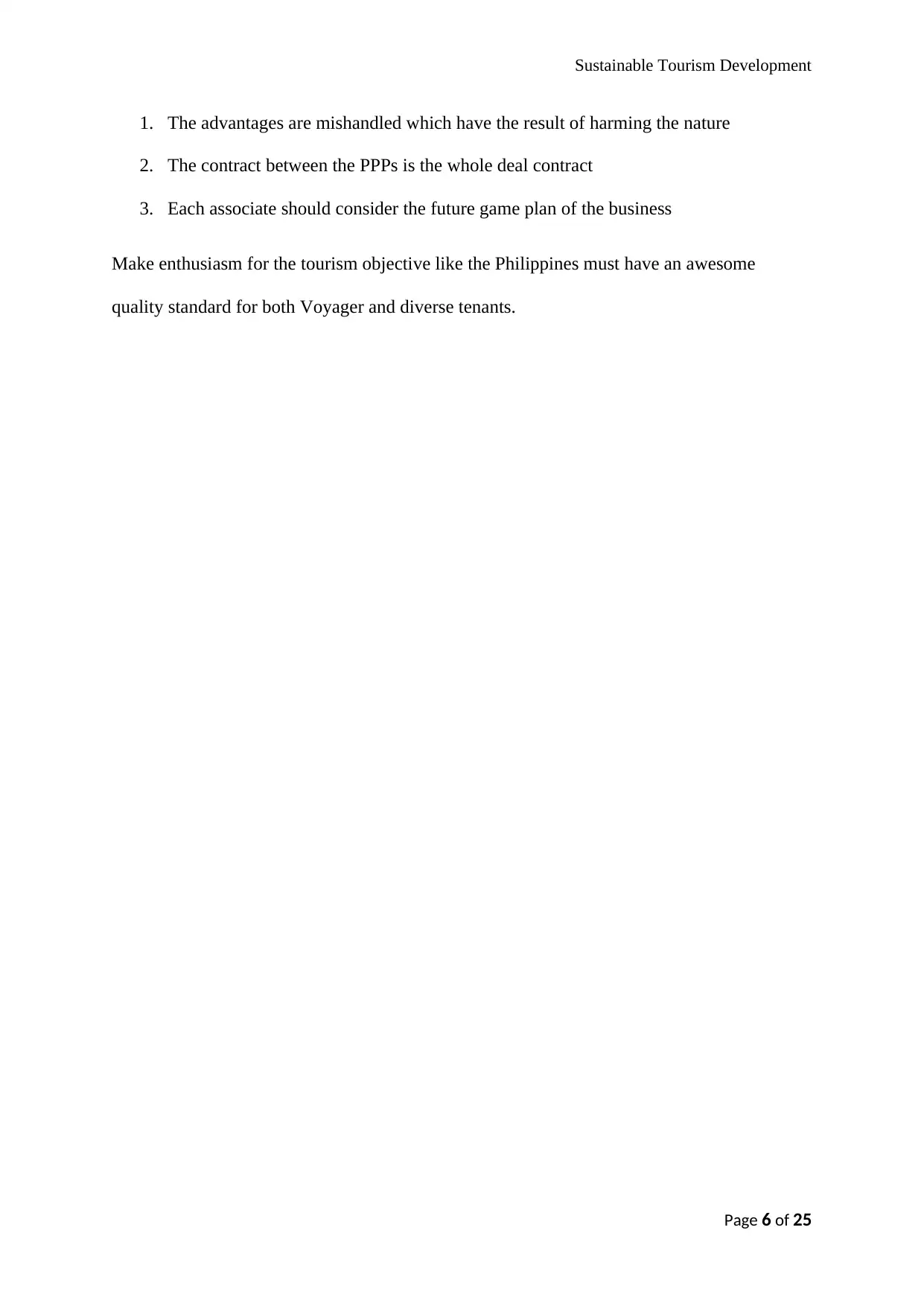
Sustainable Tourism Development
1. The advantages are mishandled which have the result of harming the nature
2. The contract between the PPPs is the whole deal contract
3. Each associate should consider the future game plan of the business
Make enthusiasm for the tourism objective like the Philippines must have an awesome
quality standard for both Voyager and diverse tenants.
Page 6 of 25
1. The advantages are mishandled which have the result of harming the nature
2. The contract between the PPPs is the whole deal contract
3. Each associate should consider the future game plan of the business
Make enthusiasm for the tourism objective like the Philippines must have an awesome
quality standard for both Voyager and diverse tenants.
Page 6 of 25
⊘ This is a preview!⊘
Do you want full access?
Subscribe today to unlock all pages.

Trusted by 1+ million students worldwide
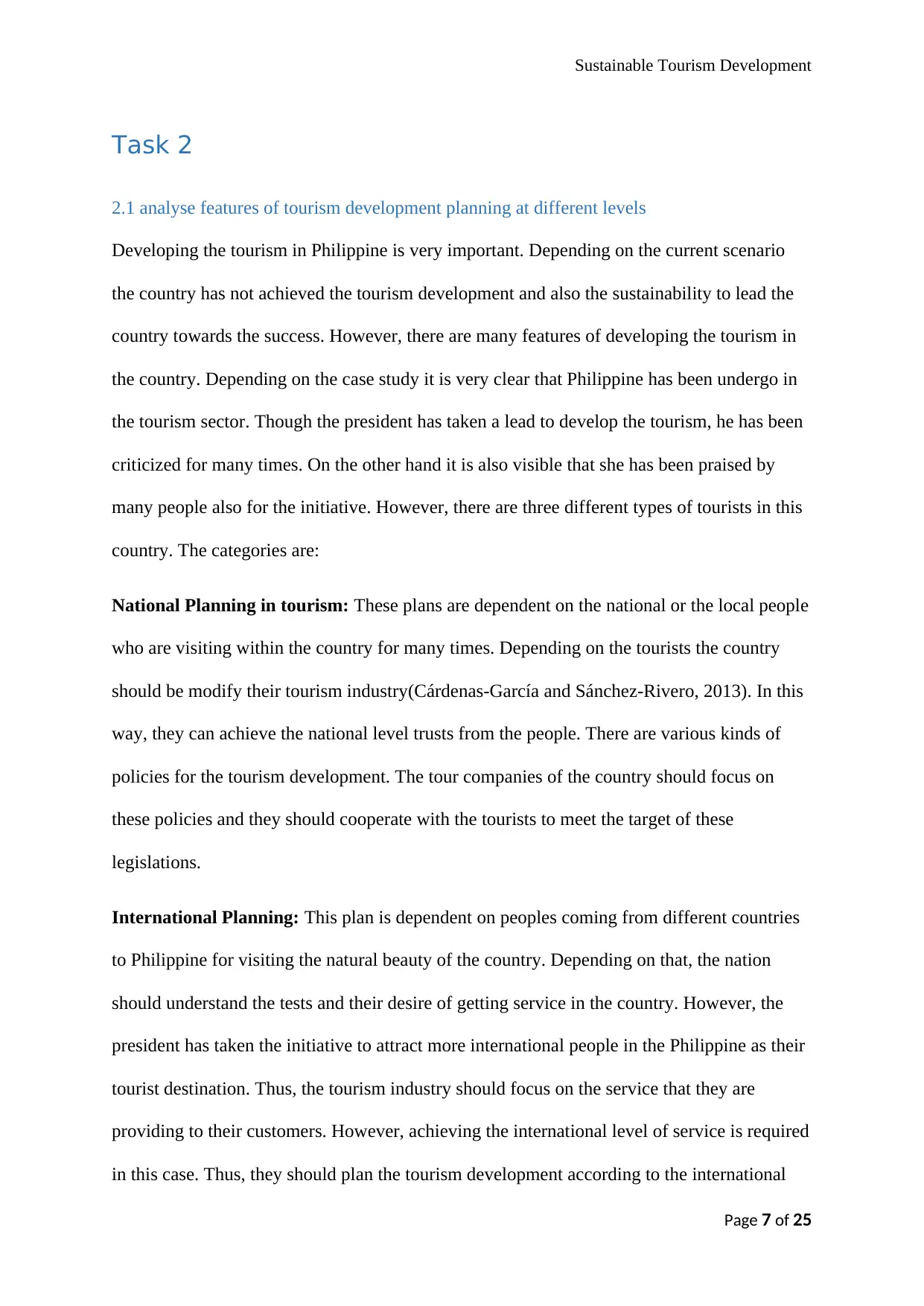
Sustainable Tourism Development
Task 2
2.1 analyse features of tourism development planning at different levels
Developing the tourism in Philippine is very important. Depending on the current scenario
the country has not achieved the tourism development and also the sustainability to lead the
country towards the success. However, there are many features of developing the tourism in
the country. Depending on the case study it is very clear that Philippine has been undergo in
the tourism sector. Though the president has taken a lead to develop the tourism, he has been
criticized for many times. On the other hand it is also visible that she has been praised by
many people also for the initiative. However, there are three different types of tourists in this
country. The categories are:
National Planning in tourism: These plans are dependent on the national or the local people
who are visiting within the country for many times. Depending on the tourists the country
should be modify their tourism industry(Cárdenas-García and Sánchez-Rivero, 2013). In this
way, they can achieve the national level trusts from the people. There are various kinds of
policies for the tourism development. The tour companies of the country should focus on
these policies and they should cooperate with the tourists to meet the target of these
legislations.
International Planning: This plan is dependent on peoples coming from different countries
to Philippine for visiting the natural beauty of the country. Depending on that, the nation
should understand the tests and their desire of getting service in the country. However, the
president has taken the initiative to attract more international people in the Philippine as their
tourist destination. Thus, the tourism industry should focus on the service that they are
providing to their customers. However, achieving the international level of service is required
in this case. Thus, they should plan the tourism development according to the international
Page 7 of 25
Task 2
2.1 analyse features of tourism development planning at different levels
Developing the tourism in Philippine is very important. Depending on the current scenario
the country has not achieved the tourism development and also the sustainability to lead the
country towards the success. However, there are many features of developing the tourism in
the country. Depending on the case study it is very clear that Philippine has been undergo in
the tourism sector. Though the president has taken a lead to develop the tourism, he has been
criticized for many times. On the other hand it is also visible that she has been praised by
many people also for the initiative. However, there are three different types of tourists in this
country. The categories are:
National Planning in tourism: These plans are dependent on the national or the local people
who are visiting within the country for many times. Depending on the tourists the country
should be modify their tourism industry(Cárdenas-García and Sánchez-Rivero, 2013). In this
way, they can achieve the national level trusts from the people. There are various kinds of
policies for the tourism development. The tour companies of the country should focus on
these policies and they should cooperate with the tourists to meet the target of these
legislations.
International Planning: This plan is dependent on peoples coming from different countries
to Philippine for visiting the natural beauty of the country. Depending on that, the nation
should understand the tests and their desire of getting service in the country. However, the
president has taken the initiative to attract more international people in the Philippine as their
tourist destination. Thus, the tourism industry should focus on the service that they are
providing to their customers. However, achieving the international level of service is required
in this case. Thus, they should plan the tourism development according to the international
Page 7 of 25
Paraphrase This Document
Need a fresh take? Get an instant paraphrase of this document with our AI Paraphraser
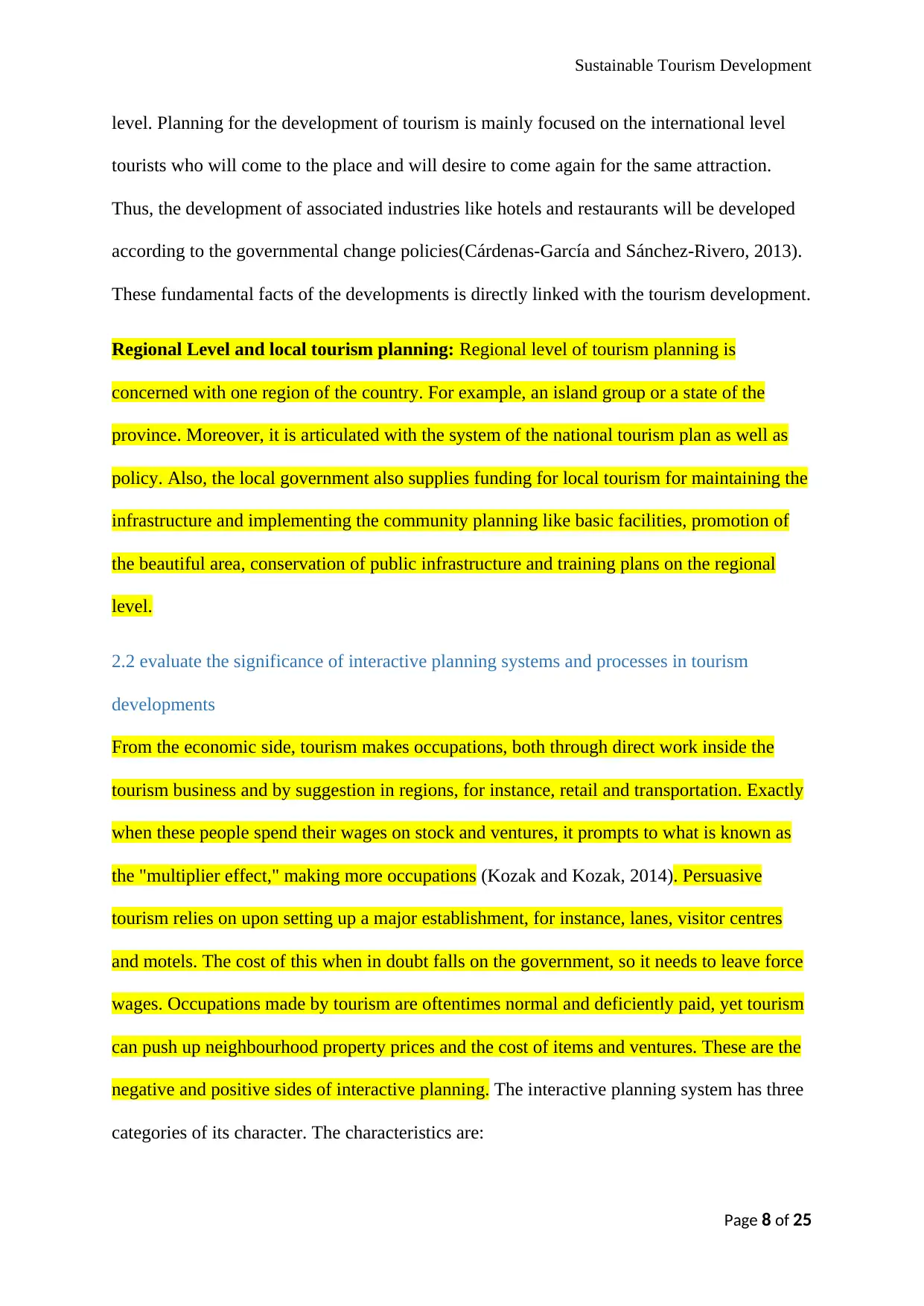
Sustainable Tourism Development
level. Planning for the development of tourism is mainly focused on the international level
tourists who will come to the place and will desire to come again for the same attraction.
Thus, the development of associated industries like hotels and restaurants will be developed
according to the governmental change policies(Cárdenas-García and Sánchez-Rivero, 2013).
These fundamental facts of the developments is directly linked with the tourism development.
Regional Level and local tourism planning: Regional level of tourism planning is
concerned with one region of the country. For example, an island group or a state of the
province. Moreover, it is articulated with the system of the national tourism plan as well as
policy. Also, the local government also supplies funding for local tourism for maintaining the
infrastructure and implementing the community planning like basic facilities, promotion of
the beautiful area, conservation of public infrastructure and training plans on the regional
level.
2.2 evaluate the significance of interactive planning systems and processes in tourism
developments
From the economic side, tourism makes occupations, both through direct work inside the
tourism business and by suggestion in regions, for instance, retail and transportation. Exactly
when these people spend their wages on stock and ventures, it prompts to what is known as
the "multiplier effect," making more occupations (Kozak and Kozak, 2014). Persuasive
tourism relies on upon setting up a major establishment, for instance, lanes, visitor centres
and motels. The cost of this when in doubt falls on the government, so it needs to leave force
wages. Occupations made by tourism are oftentimes normal and deficiently paid, yet tourism
can push up neighbourhood property prices and the cost of items and ventures. These are the
negative and positive sides of interactive planning. The interactive planning system has three
categories of its character. The characteristics are:
Page 8 of 25
level. Planning for the development of tourism is mainly focused on the international level
tourists who will come to the place and will desire to come again for the same attraction.
Thus, the development of associated industries like hotels and restaurants will be developed
according to the governmental change policies(Cárdenas-García and Sánchez-Rivero, 2013).
These fundamental facts of the developments is directly linked with the tourism development.
Regional Level and local tourism planning: Regional level of tourism planning is
concerned with one region of the country. For example, an island group or a state of the
province. Moreover, it is articulated with the system of the national tourism plan as well as
policy. Also, the local government also supplies funding for local tourism for maintaining the
infrastructure and implementing the community planning like basic facilities, promotion of
the beautiful area, conservation of public infrastructure and training plans on the regional
level.
2.2 evaluate the significance of interactive planning systems and processes in tourism
developments
From the economic side, tourism makes occupations, both through direct work inside the
tourism business and by suggestion in regions, for instance, retail and transportation. Exactly
when these people spend their wages on stock and ventures, it prompts to what is known as
the "multiplier effect," making more occupations (Kozak and Kozak, 2014). Persuasive
tourism relies on upon setting up a major establishment, for instance, lanes, visitor centres
and motels. The cost of this when in doubt falls on the government, so it needs to leave force
wages. Occupations made by tourism are oftentimes normal and deficiently paid, yet tourism
can push up neighbourhood property prices and the cost of items and ventures. These are the
negative and positive sides of interactive planning. The interactive planning system has three
categories of its character. The characteristics are:
Page 8 of 25
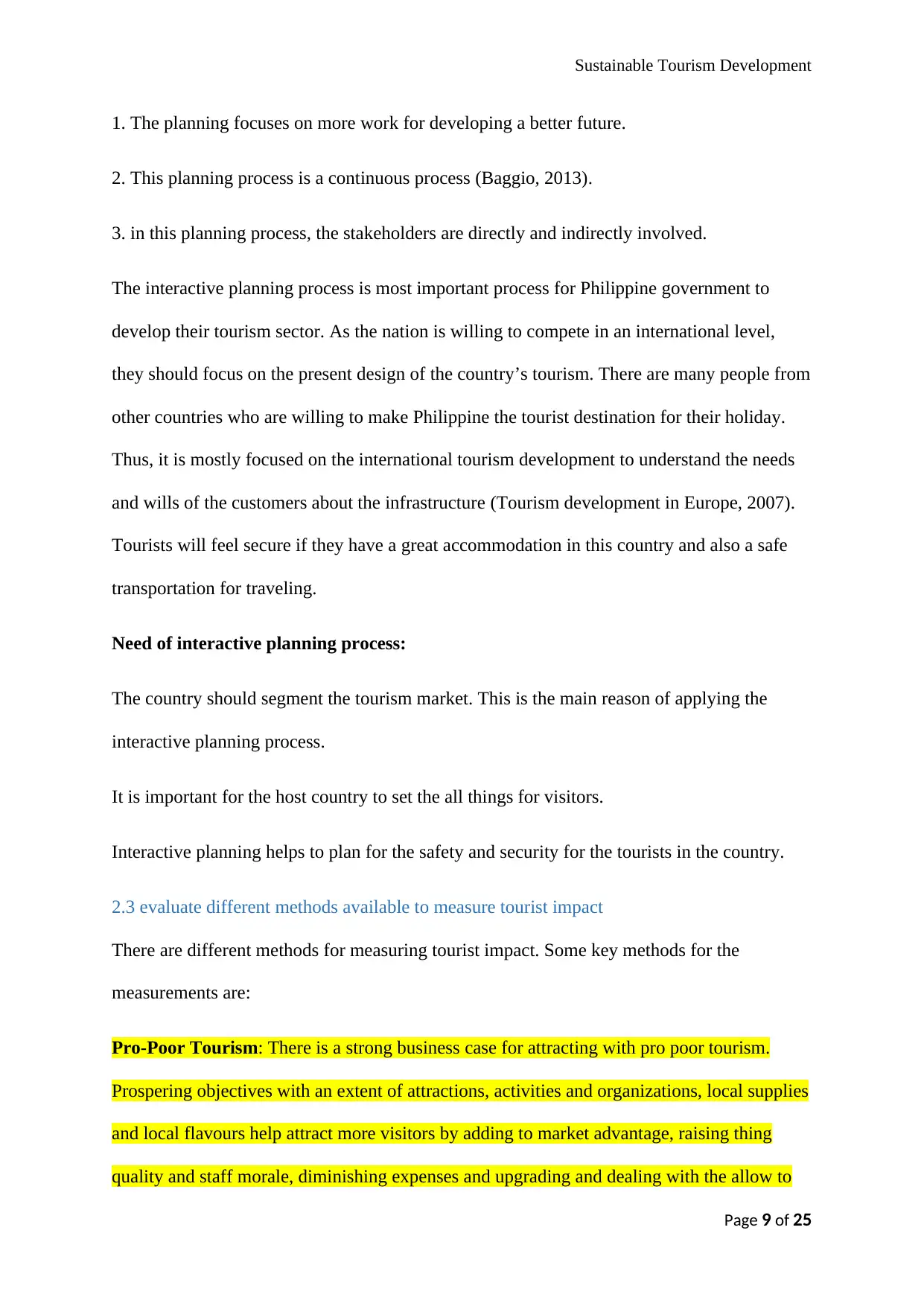
Sustainable Tourism Development
1. The planning focuses on more work for developing a better future.
2. This planning process is a continuous process (Baggio, 2013).
3. in this planning process, the stakeholders are directly and indirectly involved.
The interactive planning process is most important process for Philippine government to
develop their tourism sector. As the nation is willing to compete in an international level,
they should focus on the present design of the country’s tourism. There are many people from
other countries who are willing to make Philippine the tourist destination for their holiday.
Thus, it is mostly focused on the international tourism development to understand the needs
and wills of the customers about the infrastructure (Tourism development in Europe, 2007).
Tourists will feel secure if they have a great accommodation in this country and also a safe
transportation for traveling.
Need of interactive planning process:
The country should segment the tourism market. This is the main reason of applying the
interactive planning process.
It is important for the host country to set the all things for visitors.
Interactive planning helps to plan for the safety and security for the tourists in the country.
2.3 evaluate different methods available to measure tourist impact
There are different methods for measuring tourist impact. Some key methods for the
measurements are:
Pro-Poor Tourism: There is a strong business case for attracting with pro poor tourism.
Prospering objectives with an extent of attractions, activities and organizations, local supplies
and local flavours help attract more visitors by adding to market advantage, raising thing
quality and staff morale, diminishing expenses and upgrading and dealing with the allow to
Page 9 of 25
1. The planning focuses on more work for developing a better future.
2. This planning process is a continuous process (Baggio, 2013).
3. in this planning process, the stakeholders are directly and indirectly involved.
The interactive planning process is most important process for Philippine government to
develop their tourism sector. As the nation is willing to compete in an international level,
they should focus on the present design of the country’s tourism. There are many people from
other countries who are willing to make Philippine the tourist destination for their holiday.
Thus, it is mostly focused on the international tourism development to understand the needs
and wills of the customers about the infrastructure (Tourism development in Europe, 2007).
Tourists will feel secure if they have a great accommodation in this country and also a safe
transportation for traveling.
Need of interactive planning process:
The country should segment the tourism market. This is the main reason of applying the
interactive planning process.
It is important for the host country to set the all things for visitors.
Interactive planning helps to plan for the safety and security for the tourists in the country.
2.3 evaluate different methods available to measure tourist impact
There are different methods for measuring tourist impact. Some key methods for the
measurements are:
Pro-Poor Tourism: There is a strong business case for attracting with pro poor tourism.
Prospering objectives with an extent of attractions, activities and organizations, local supplies
and local flavours help attract more visitors by adding to market advantage, raising thing
quality and staff morale, diminishing expenses and upgrading and dealing with the allow to
Page 9 of 25
⊘ This is a preview!⊘
Do you want full access?
Subscribe today to unlock all pages.

Trusted by 1+ million students worldwide
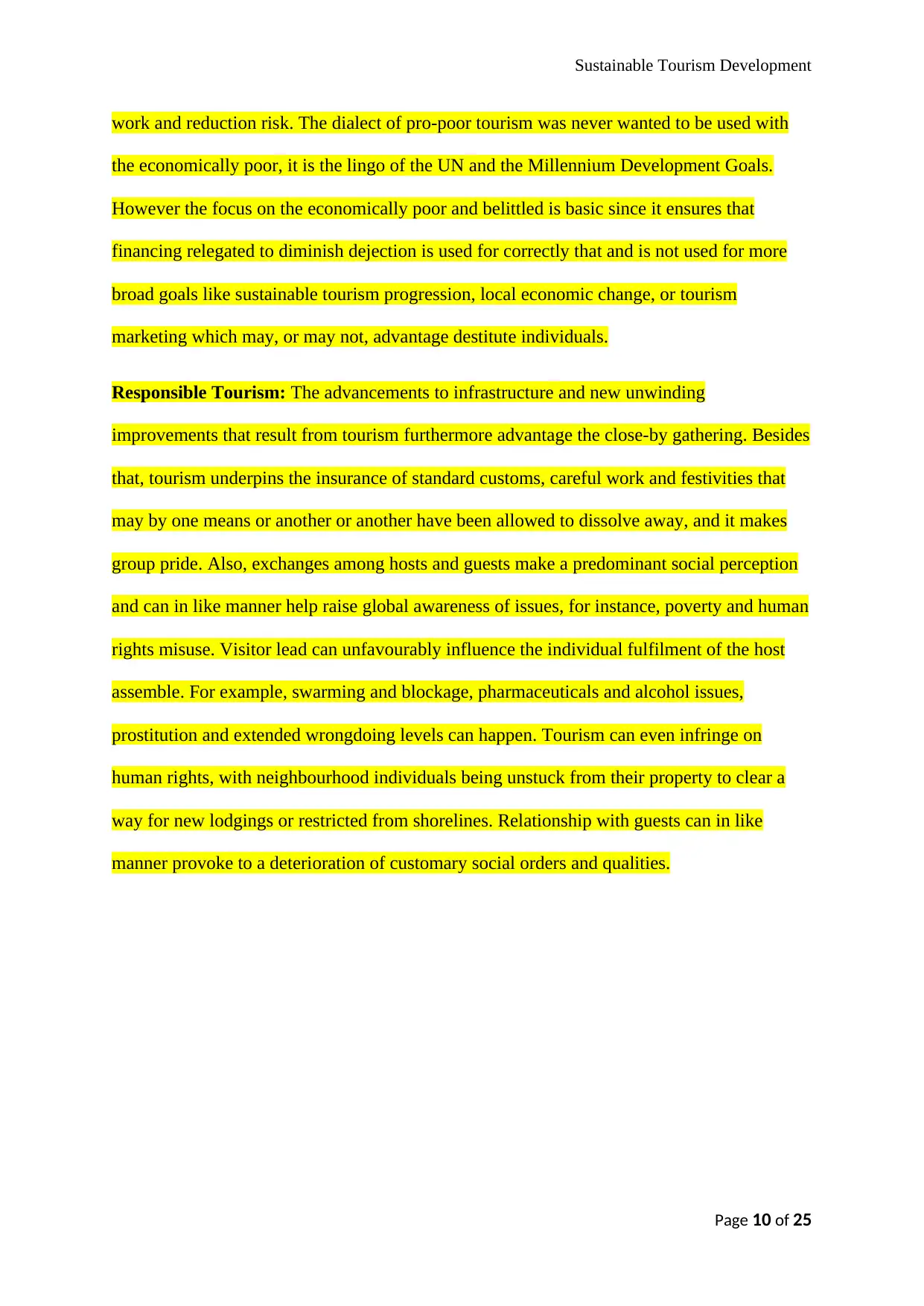
Sustainable Tourism Development
work and reduction risk. The dialect of pro-poor tourism was never wanted to be used with
the economically poor, it is the lingo of the UN and the Millennium Development Goals.
However the focus on the economically poor and belittled is basic since it ensures that
financing relegated to diminish dejection is used for correctly that and is not used for more
broad goals like sustainable tourism progression, local economic change, or tourism
marketing which may, or may not, advantage destitute individuals.
Responsible Tourism: The advancements to infrastructure and new unwinding
improvements that result from tourism furthermore advantage the close-by gathering. Besides
that, tourism underpins the insurance of standard customs, careful work and festivities that
may by one means or another or another have been allowed to dissolve away, and it makes
group pride. Also, exchanges among hosts and guests make a predominant social perception
and can in like manner help raise global awareness of issues, for instance, poverty and human
rights misuse. Visitor lead can unfavourably influence the individual fulfilment of the host
assemble. For example, swarming and blockage, pharmaceuticals and alcohol issues,
prostitution and extended wrongdoing levels can happen. Tourism can even infringe on
human rights, with neighbourhood individuals being unstuck from their property to clear a
way for new lodgings or restricted from shorelines. Relationship with guests can in like
manner provoke to a deterioration of customary social orders and qualities.
Page 10 of 25
work and reduction risk. The dialect of pro-poor tourism was never wanted to be used with
the economically poor, it is the lingo of the UN and the Millennium Development Goals.
However the focus on the economically poor and belittled is basic since it ensures that
financing relegated to diminish dejection is used for correctly that and is not used for more
broad goals like sustainable tourism progression, local economic change, or tourism
marketing which may, or may not, advantage destitute individuals.
Responsible Tourism: The advancements to infrastructure and new unwinding
improvements that result from tourism furthermore advantage the close-by gathering. Besides
that, tourism underpins the insurance of standard customs, careful work and festivities that
may by one means or another or another have been allowed to dissolve away, and it makes
group pride. Also, exchanges among hosts and guests make a predominant social perception
and can in like manner help raise global awareness of issues, for instance, poverty and human
rights misuse. Visitor lead can unfavourably influence the individual fulfilment of the host
assemble. For example, swarming and blockage, pharmaceuticals and alcohol issues,
prostitution and extended wrongdoing levels can happen. Tourism can even infringe on
human rights, with neighbourhood individuals being unstuck from their property to clear a
way for new lodgings or restricted from shorelines. Relationship with guests can in like
manner provoke to a deterioration of customary social orders and qualities.
Page 10 of 25
Paraphrase This Document
Need a fresh take? Get an instant paraphrase of this document with our AI Paraphraser
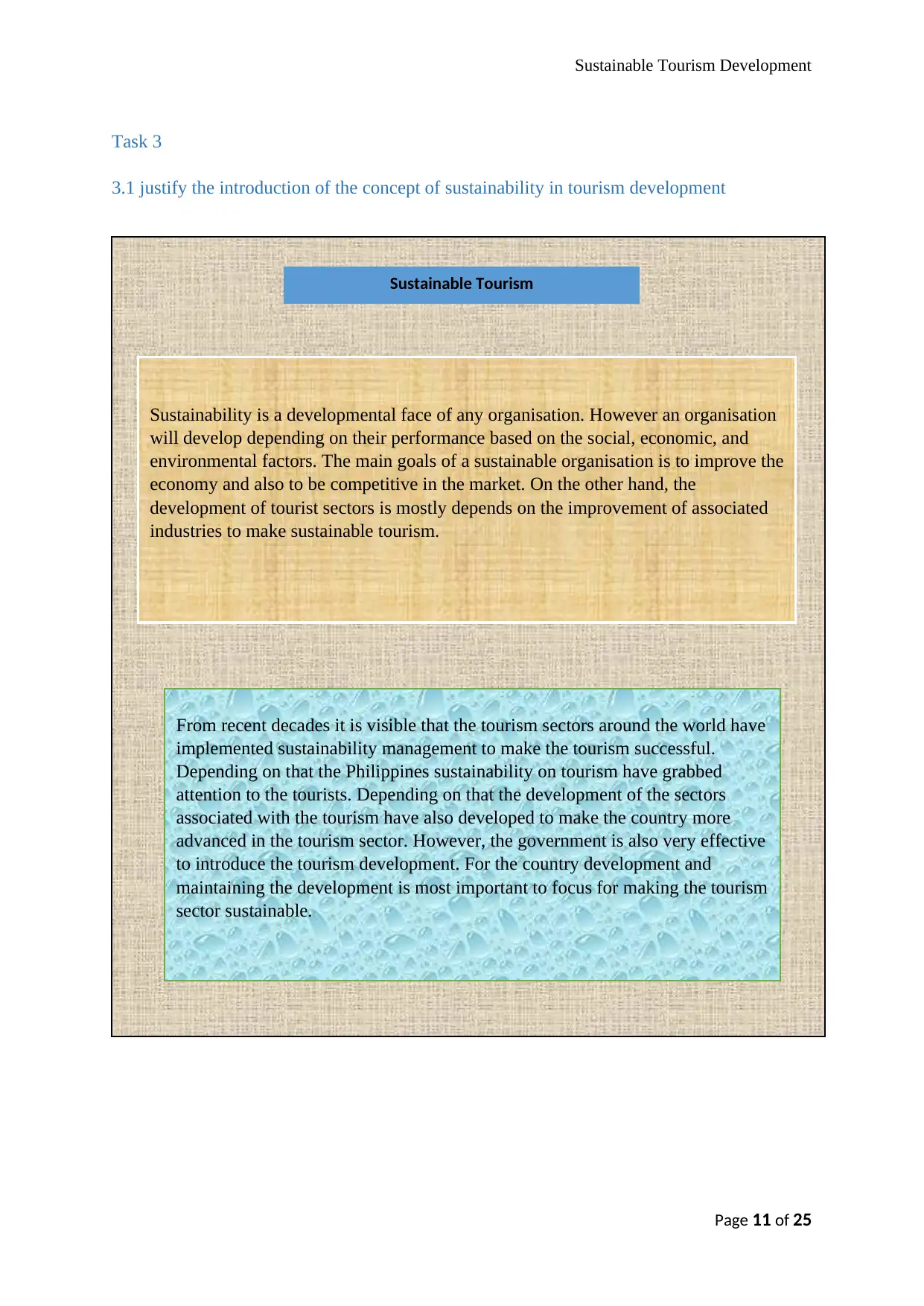
Sustainable Tourism Development
Task 3
3.1 justify the introduction of the concept of sustainability in tourism development
Page 11 of 25
Sustainable Tourism
Sustainability is a developmental face of any organisation. However an organisation
will develop depending on their performance based on the social, economic, and
environmental factors. The main goals of a sustainable organisation is to improve the
economy and also to be competitive in the market. On the other hand, the
development of tourist sectors is mostly depends on the improvement of associated
industries to make sustainable tourism.
From recent decades it is visible that the tourism sectors around the world have
implemented sustainability management to make the tourism successful.
Depending on that the Philippines sustainability on tourism have grabbed
attention to the tourists. Depending on that the development of the sectors
associated with the tourism have also developed to make the country more
advanced in the tourism sector. However, the government is also very effective
to introduce the tourism development. For the country development and
maintaining the development is most important to focus for making the tourism
sector sustainable.
Task 3
3.1 justify the introduction of the concept of sustainability in tourism development
Page 11 of 25
Sustainable Tourism
Sustainability is a developmental face of any organisation. However an organisation
will develop depending on their performance based on the social, economic, and
environmental factors. The main goals of a sustainable organisation is to improve the
economy and also to be competitive in the market. On the other hand, the
development of tourist sectors is mostly depends on the improvement of associated
industries to make sustainable tourism.
From recent decades it is visible that the tourism sectors around the world have
implemented sustainability management to make the tourism successful.
Depending on that the Philippines sustainability on tourism have grabbed
attention to the tourists. Depending on that the development of the sectors
associated with the tourism have also developed to make the country more
advanced in the tourism sector. However, the government is also very effective
to introduce the tourism development. For the country development and
maintaining the development is most important to focus for making the tourism
sector sustainable.
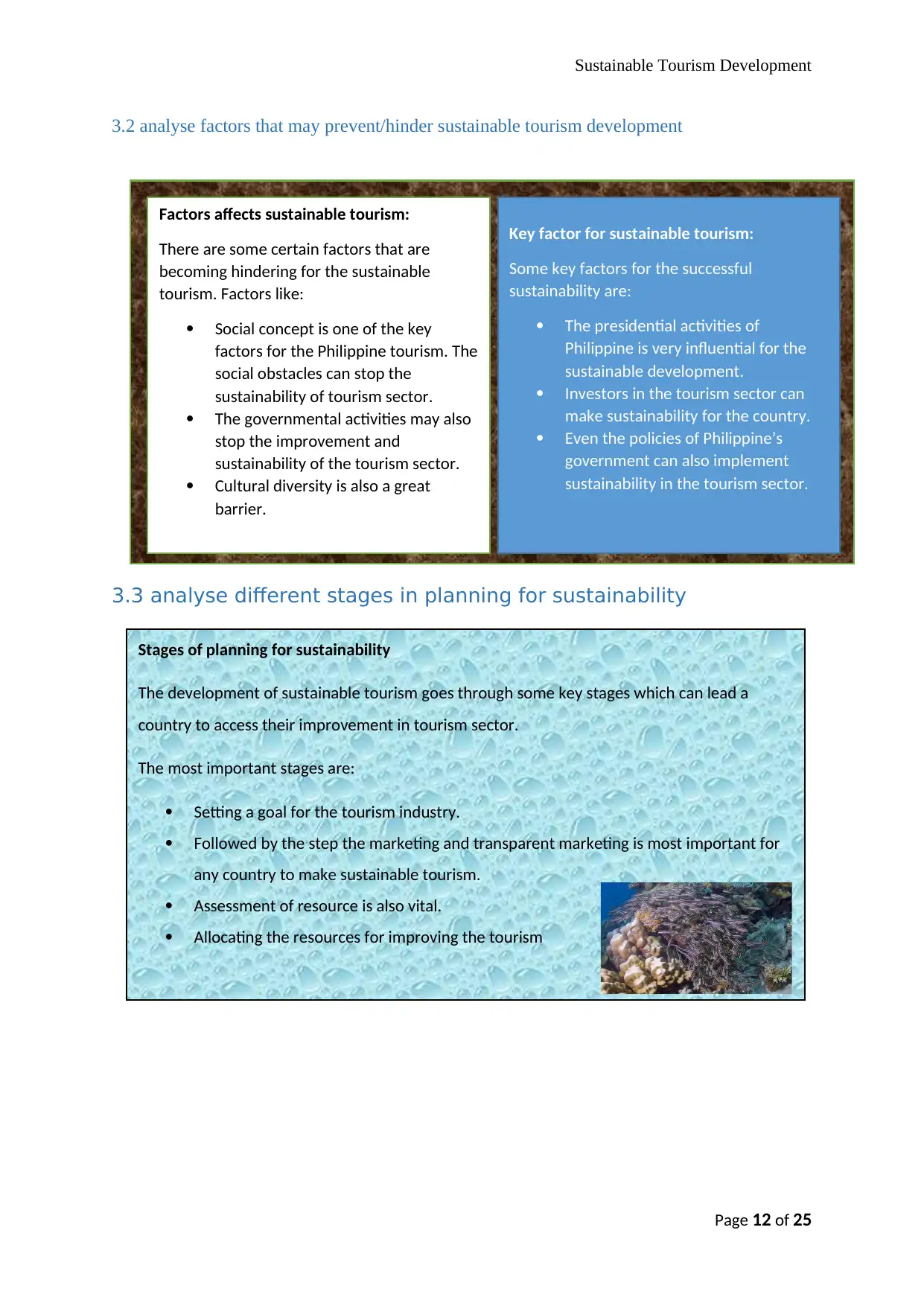
Sustainable Tourism Development
3.2 analyse factors that may prevent/hinder sustainable tourism development
3.3 analyse different stages in planning for sustainability
Page 12 of 25
Factors affects sustainable tourism:
There are some certain factors that are
becoming hindering for the sustainable
tourism. Factors like:
Social concept is one of the key
factors for the Philippine tourism. The
social obstacles can stop the
sustainability of tourism sector.
The governmental activities may also
stop the improvement and
sustainability of the tourism sector.
Cultural diversity is also a great
barrier.
Key factor for sustainable tourism:
Some key factors for the successful
sustainability are:
The presidential activities of
Philippine is very influential for the
sustainable development.
Investors in the tourism sector can
make sustainability for the country.
Even the policies of Philippine’s
government can also implement
sustainability in the tourism sector.
Stages of planning for sustainability
The development of sustainable tourism goes through some key stages which can lead a
country to access their improvement in tourism sector.
The most important stages are:
Setting a goal for the tourism industry.
Followed by the step the marketing and transparent marketing is most important for
any country to make sustainable tourism.
Assessment of resource is also vital.
Allocating the resources for improving the tourism
3.2 analyse factors that may prevent/hinder sustainable tourism development
3.3 analyse different stages in planning for sustainability
Page 12 of 25
Factors affects sustainable tourism:
There are some certain factors that are
becoming hindering for the sustainable
tourism. Factors like:
Social concept is one of the key
factors for the Philippine tourism. The
social obstacles can stop the
sustainability of tourism sector.
The governmental activities may also
stop the improvement and
sustainability of the tourism sector.
Cultural diversity is also a great
barrier.
Key factor for sustainable tourism:
Some key factors for the successful
sustainability are:
The presidential activities of
Philippine is very influential for the
sustainable development.
Investors in the tourism sector can
make sustainability for the country.
Even the policies of Philippine’s
government can also implement
sustainability in the tourism sector.
Stages of planning for sustainability
The development of sustainable tourism goes through some key stages which can lead a
country to access their improvement in tourism sector.
The most important stages are:
Setting a goal for the tourism industry.
Followed by the step the marketing and transparent marketing is most important for
any country to make sustainable tourism.
Assessment of resource is also vital.
Allocating the resources for improving the tourism
⊘ This is a preview!⊘
Do you want full access?
Subscribe today to unlock all pages.

Trusted by 1+ million students worldwide
1 out of 25
Related Documents
Your All-in-One AI-Powered Toolkit for Academic Success.
+13062052269
info@desklib.com
Available 24*7 on WhatsApp / Email
![[object Object]](/_next/static/media/star-bottom.7253800d.svg)
Unlock your academic potential
Copyright © 2020–2025 A2Z Services. All Rights Reserved. Developed and managed by ZUCOL.





